Xing Fan
Multimodal Policy Internalization for Conversational Agents
Oct 10, 2025Abstract:Modern conversational agents like ChatGPT and Alexa+ rely on predefined policies specifying metadata, response styles, and tool-usage rules. As these LLM-based systems expand to support diverse business and user queries, such policies, often implemented as in-context prompts, are becoming increasingly complex and lengthy, making faithful adherence difficult and imposing large fixed computational costs. With the rise of multimodal agents, policies that govern visual and multimodal behaviors are critical but remain understudied. Prior prompt-compression work mainly shortens task templates and demonstrations, while existing policy-alignment studies focus only on text-based safety rules. We introduce Multimodal Policy Internalization (MPI), a new task that internalizes reasoning-intensive multimodal policies into model parameters, enabling stronger policy-following without including the policy during inference. MPI poses unique data and algorithmic challenges. We build two datasets spanning synthetic and real-world decision-making and tool-using tasks and propose TriMPI, a three-stage training framework. TriMPI first injects policy knowledge via continual pretraining, then performs supervised finetuning, and finally applies PolicyRollout, a GRPO-style reinforcement learning extension that augments rollouts with policy-aware responses for grounded exploration. TriMPI achieves notable gains in end-to-end accuracy, generalization, and robustness to forgetting. As the first work on multimodal policy internalization, we provide datasets, training recipes, and comprehensive evaluations to foster future research. Project page: https://mikewangwzhl.github.io/TriMPI.
GLM-4.5: Agentic, Reasoning, and Coding (ARC) Foundation Models
Aug 08, 2025Abstract:We present GLM-4.5, an open-source Mixture-of-Experts (MoE) large language model with 355B total parameters and 32B activated parameters, featuring a hybrid reasoning method that supports both thinking and direct response modes. Through multi-stage training on 23T tokens and comprehensive post-training with expert model iteration and reinforcement learning, GLM-4.5 achieves strong performance across agentic, reasoning, and coding (ARC) tasks, scoring 70.1% on TAU-Bench, 91.0% on AIME 24, and 64.2% on SWE-bench Verified. With much fewer parameters than several competitors, GLM-4.5 ranks 3rd overall among all evaluated models and 2nd on agentic benchmarks. We release both GLM-4.5 (355B parameters) and a compact version, GLM-4.5-Air (106B parameters), to advance research in reasoning and agentic AI systems. Code, models, and more information are available at https://github.com/zai-org/GLM-4.5.
Memetic Search for Green Vehicle Routing Problem with Private Capacitated Refueling Stations
Apr 06, 2025Abstract:The green vehicle routing problem with private capacitated alternative fuel stations (GVRP-PCAFS) extends the traditional green vehicle routing problem by considering refueling stations limited capacity, where a limited number of vehicles can refuel simultaneously with additional vehicles must wait. This feature presents new challenges for route planning, as waiting times at stations must be managed while keeping route durations within limits and reducing total travel distance. This article presents METS, a novel memetic algorithm (MA) with separate constraint-based tour segmentation (SCTS) and efficient local search (ELS) for solving GVRP-PCAFS. METS combines global and local search effectively through three novelties. For global search, the SCTS strategy splits giant tours to generate diverse solutions, and the search process is guided by a comprehensive fitness evaluation function to dynamically control feasibility and diversity to produce solutions that are both diverse and near-feasible. For local search, ELS incorporates tailored move operators with constant-time move evaluation mechanisms, enabling efficient exploration of large solution neighborhoods. Experimental results demonstrate that METS discovers 31 new best-known solutions out of 40 instances in existing benchmark sets, achieving substantial improvements over current state-of-the-art methods. Additionally, a new large-scale benchmark set based on real-world logistics data is introduced to facilitate future research.
LLM-Virus: Evolutionary Jailbreak Attack on Large Language Models
Dec 28, 2024



Abstract:While safety-aligned large language models (LLMs) are increasingly used as the cornerstone for powerful systems such as multi-agent frameworks to solve complex real-world problems, they still suffer from potential adversarial queries, such as jailbreak attacks, which attempt to induce harmful content. Researching attack methods allows us to better understand the limitations of LLM and make trade-offs between helpfulness and safety. However, existing jailbreak attacks are primarily based on opaque optimization techniques (e.g. token-level gradient descent) and heuristic search methods like LLM refinement, which fall short in terms of transparency, transferability, and computational cost. In light of these limitations, we draw inspiration from the evolution and infection processes of biological viruses and propose LLM-Virus, a jailbreak attack method based on evolutionary algorithm, termed evolutionary jailbreak. LLM-Virus treats jailbreak attacks as both an evolutionary and transfer learning problem, utilizing LLMs as heuristic evolutionary operators to ensure high attack efficiency, transferability, and low time cost. Our experimental results on multiple safety benchmarks show that LLM-Virus achieves competitive or even superior performance compared to existing attack methods.
Multi-scale Temporal Fusion Transformer for Incomplete Vehicle Trajectory Prediction
Sep 02, 2024
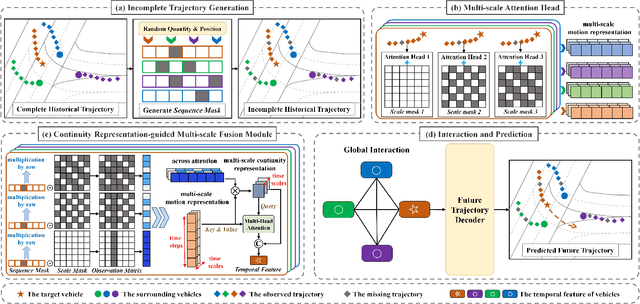

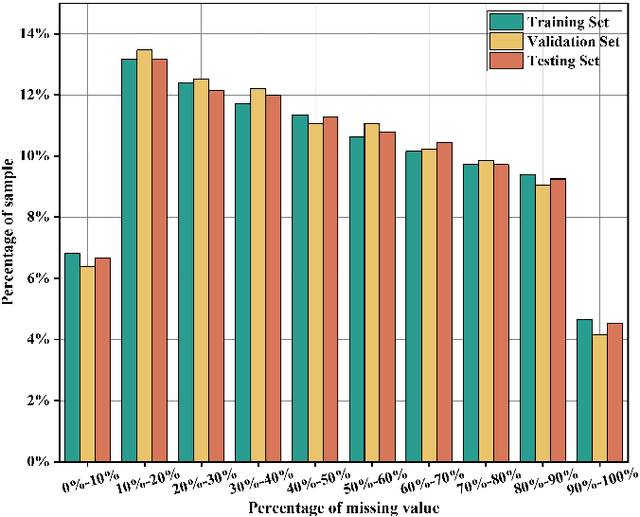
Abstract:Motion prediction plays an essential role in autonomous driving systems, enabling autonomous vehicles to achieve more accurate local-path planning and driving decisions based on predictions of the surrounding vehicles. However, existing methods neglect the potential missing values caused by object occlusion, perception failures, etc., which inevitably degrades the trajectory prediction performance in real traffic scenarios. To address this limitation, we propose a novel end-to-end framework for incomplete vehicle trajectory prediction, named Multi-scale Temporal Fusion Transformer (MTFT), which consists of the Multi-scale Attention Head (MAH) and the Continuity Representation-guided Multi-scale Fusion (CRMF) module. Specifically, the MAH leverages the multi-head attention mechanism to parallelly capture multi-scale motion representation of trajectory from different temporal granularities, thus mitigating the adverse effect of missing values on prediction. Furthermore, the multi-scale motion representation is input into the CRMF module for multi-scale fusion to obtain the robust temporal feature of the vehicle. During the fusion process, the continuity representation of vehicle motion is first extracted across time steps to guide the fusion, ensuring that the resulting temporal feature incorporates both detailed information and the overall trend of vehicle motion, which facilitates the accurate decoding of future trajectory that is consistent with the vehicle's motion trend. We evaluate the proposed model on four datasets derived from highway and urban traffic scenarios. The experimental results demonstrate its superior performance in the incomplete vehicle trajectory prediction task compared with state-of-the-art models, e.g., a comprehensive performance improvement of more than 39% on the HighD dataset.
RecMind: Large Language Model Powered Agent For Recommendation
Aug 28, 2023



Abstract:Recent advancements in instructing Large Language Models (LLMs) to utilize external tools and execute multi-step plans have significantly enhanced their ability to solve intricate tasks, ranging from mathematical problems to creative writing. Yet, there remains a notable gap in studying the capacity of LLMs in responding to personalized queries such as a recommendation request. To bridge this gap, we have designed an LLM-powered autonomous recommender agent, RecMind, which is capable of providing precise personalized recommendations through careful planning, utilizing tools for obtaining external knowledge, and leveraging individual data. We propose a novel algorithm, Self-Inspiring, to improve the planning ability of the LLM agent. At each intermediate planning step, the LLM 'self-inspires' to consider all previously explored states to plan for next step. This mechanism greatly improves the model's ability to comprehend and utilize historical planning information for recommendation. We evaluate RecMind's performance in various recommendation scenarios, including rating prediction, sequential recommendation, direct recommendation, explanation generation, and review summarization. Our experiment shows that RecMind outperforms existing zero/few-shot LLM-based recommendation methods in different recommendation tasks and achieves competitive performance to a recent model P5, which requires fully pre-train for the recommendation tasks.
Multi-Task Knowledge Enhancement for Zero-Shot and Multi-Domain Recommendation in an AI Assistant Application
Jun 09, 2023Abstract:Recommender systems have found significant commercial success but still struggle with integrating new users. Since users often interact with content in different domains, it is possible to leverage a user's interactions in previous domains to improve that user's recommendations in a new one (multi-domain recommendation). A separate research thread on knowledge graph enhancement uses external knowledge graphs to improve single domain recommendations (knowledge graph enhancement). Both research threads incorporate related information to improve predictions in a new domain. We propose in this work to unify these approaches: Using information from interactions in other domains as well as external knowledge graphs to make predictions in a new domain that would be impossible with either information source alone. We apply these ideas to a dataset derived from millions of users' requests for content across three domains (videos, music, and books) in a live virtual assistant application. We demonstrate the advantage of combining knowledge graph enhancement with previous multi-domain recommendation techniques to provide better overall recommendations as well as for better recommendations on new users of a domain.
KG-ECO: Knowledge Graph Enhanced Entity Correction for Query Rewriting
Feb 22, 2023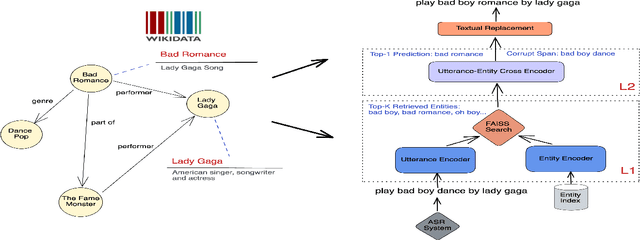



Abstract:Query Rewriting (QR) plays a critical role in large-scale dialogue systems for reducing frictions. When there is an entity error, it imposes extra challenges for a dialogue system to produce satisfactory responses. In this work, we propose KG-ECO: Knowledge Graph enhanced Entity COrrection for query rewriting, an entity correction system with corrupt entity span detection and entity retrieval/re-ranking functionalities. To boost the model performance, we incorporate Knowledge Graph (KG) to provide entity structural information (neighboring entities encoded by graph neural networks) and textual information (KG entity descriptions encoded by RoBERTa). Experimental results show that our approach yields a clear performance gain over two baselines: utterance level QR and entity correction without utilizing KG information. The proposed system is particularly effective for few-shot learning cases where target entities are rarely seen in training or there is a KG relation between the target entity and other contextual entities in the query.
Robust Regularized Low-Rank Matrix Models for Regression and Classification
May 14, 2022
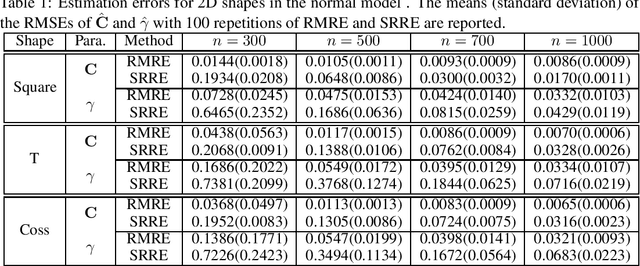
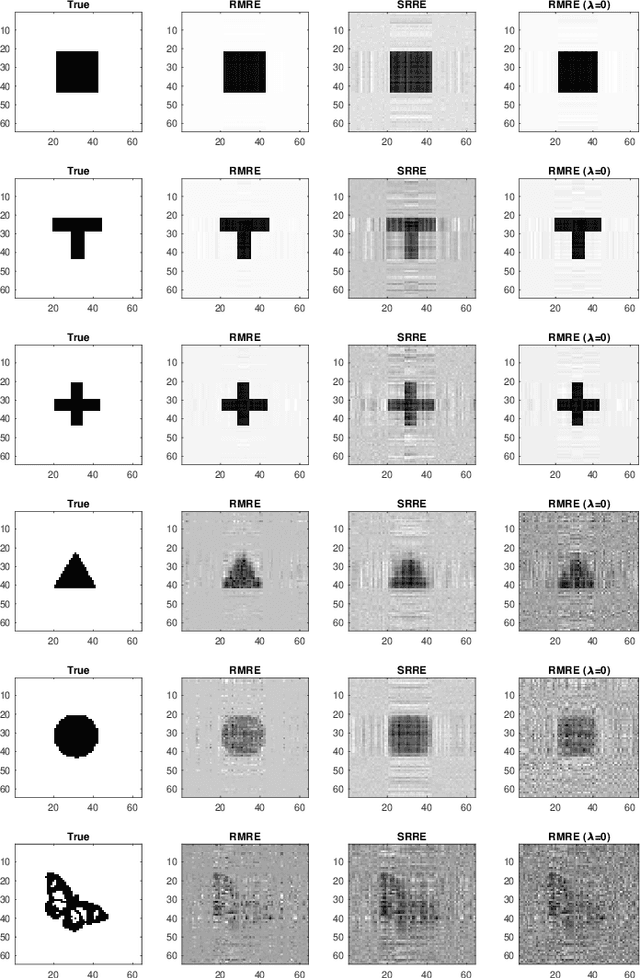

Abstract:While matrix variate regression models have been studied in many existing works, classical statistical and computational methods for the analysis of the regression coefficient estimation are highly affected by high dimensional and noisy matrix-valued predictors. To address these issues, this paper proposes a framework of matrix variate regression models based on a rank constraint, vector regularization (e.g., sparsity), and a general loss function with three special cases considered: ordinary matrix regression, robust matrix regression, and matrix logistic regression. We also propose an alternating projected gradient descent algorithm. Based on analyzing our objective functions on manifolds with bounded curvature, we show that the algorithm is guaranteed to converge, all accumulation points of the iterates have estimation errors in the order of $O(1/\sqrt{n})$ asymptotically and substantially attaining the minimax rate. Our theoretical analysis can be applied to general optimization problems on manifolds with bounded curvature and can be considered an important technical contribution to this work. We validate the proposed method through simulation studies and real image data examples.
Learning to Selectively Learn for Weakly-supervised Paraphrase Generation
Sep 25, 2021


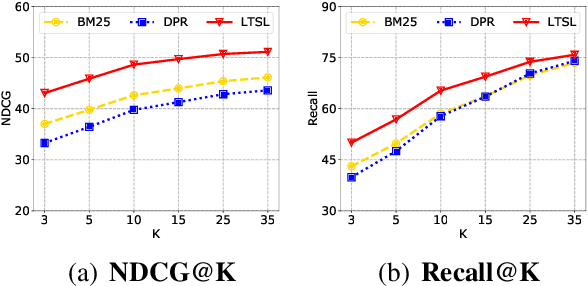
Abstract:Paraphrase generation is a longstanding NLP task that has diverse applications for downstream NLP tasks. However, the effectiveness of existing efforts predominantly relies on large amounts of golden labeled data. Though unsupervised endeavors have been proposed to address this issue, they may fail to generate meaningful paraphrases due to the lack of supervision signals. In this work, we go beyond the existing paradigms and propose a novel approach to generate high-quality paraphrases with weak supervision data. Specifically, we tackle the weakly-supervised paraphrase generation problem by: (1) obtaining abundant weakly-labeled parallel sentences via retrieval-based pseudo paraphrase expansion; and (2) developing a meta-learning framework to progressively select valuable samples for fine-tuning a pre-trained language model, i.e., BART, on the sentential paraphrasing task. We demonstrate that our approach achieves significant improvements over existing unsupervised approaches, and is even comparable in performance with supervised state-of-the-arts.
 Add to Chrome
Add to Chrome Add to Firefox
Add to Firefox Add to Edge
Add to Edge